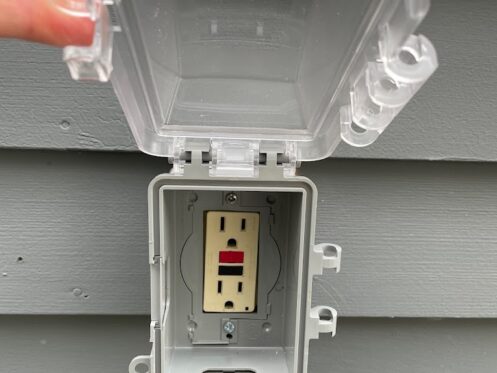The electrical system is always the most dangerous part of any building. That’s why all modern electrical systems have various safety features, like circuit breakers that are designed to minimize the risk of fires and electrocution. Another essential safety feature that every home should have is ground fault circuit interrupter outlets and breakers. In this guide, we’ll explain exactly how ground fault circuit interrupters help to reduce the risk of electrocution and everything else you need to know about them.
Understanding the Danger of Ground Faults
A ground fault is potentially one of the most hazardous electrical issues since it creates an extreme risk of electrical shock or even fatal electrocution. The first thing to understand about electricity is that the current naturally tries to find a path to the ground and always takes the path that provides the least amount of resistance. Under normal circumstances, this isn’t an issue since each electrical circuit in a house is a closed loop, meaning that the current has no way to escape or leak out.
The issue is when moisture comes into contact with an outlet or wire since the current can flow through the water into any nearby metal items. The metal item then becomes energized. The same thing can happen if a damaged wire touches anything metal. For instance, if the cord on your toaster is damaged, the current can flow out and energize the metal body of the toaster. A ground fault is when the current escapes into a different path that allows it a route to the ground, such as a person. If you were then to touch the energized toaster or a wet outlet, a ground fault would occur since the electricity would flow through your body and result in a nasty shock, if not fatally electrocute you.
How Ground Fault Circuit Interrupters Improve Electrical Safety
The purpose of ground fault circuit interrupters (GFCI) is to stop power from continuing to flow should a ground fault ever occur. A GFCI is essentially a circuit breaker that works by constantly monitoring or measuring the amperage of the electrical current flowing through it. Under normal circumstances, the amperage of the current flowing through the live wire and the neutral wire are exactly the same. That’s because the current flows out of the electrical panel through the live wire and then back to the panel through the neutral wire. A ground fault always results in the amperage of the current flowing through the live wire spiking due to the current taking a different path where it encounters less resistance.
GFCIs are extremely sensitive and can detect even tiny spikes in amperage. When a spike occurs, the GFCI trips so that the current instantly stops flowing. These devices are extensive and trip quickly, so there is almost zero chance of the ground fault causing you to get shocked or electrocuted. In fact, they work so well that there has been close to a 90% reduction in electrocutions caused by consumer appliances since GFCIs were first introduced.
Which Parts of a Home Require GFCI Protection?
There are both GFCI outlets and GFCI circuit breakers, and the National Electric Code requires all new homes to have one or the other in certain locations. GFCI outlets are more common and generally considered safer since they are easier to test. The situations where you generally need to use a GFCI circuit breaker instead of an interrupter are for dedicated 240-volt circuits since they currently don’t make 240-volt GFCI outlets. This includes circuits like the 240-volt circuit that serves a clothes dryer and any 240-volt circuits in a garage.
Generally speaking, GFCI protection is required in all places where a circuit or any wiring could potentially be exposed to water. The most recent version of the National Electric Code requires GFCI protection for all power receptacles in a kitchen, bathroom, laundry room, utility room and basement. All outdoor receptacles must also have a GFCI outlet or be wired to a circuit controlled by a GFCI circuit breaker. GFCI protection is also required in places like a garage or shed where power tools and other high-power devices can be more easily damaged and cause a ground fault.
In an existing home, you’re only legally required to install GFCI outlets and breakers in all of the necessary places if you’re renovating most of your house. Nonetheless, it’s something we recommend doing so that you can reduce the chances of anyone getting electrocuted.
Our Electricians
Plugz Electric has years of experience providing safe, reliable residential and commercial electrical services in Forest Lake and throughout the Twin Cities Metro area. We specialize in electrical installations and upgrades and are ready to help if you need to install any GFCI outlets or breakers in your home or business. For more information or to schedule a service call for any electrical installation or repair services, contact us today.



